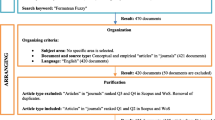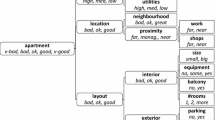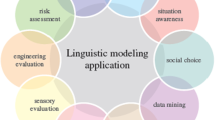Abstract
This paper presents a new interpretive structural modeling (ISM) technique based on linguistic term sets. In the proposed approach, the linguistic terms will replace binary numbers 0 and 1, representing one attribute's influence on another. The main objective is to introduce the concept of linguistic term sets to the ISM and develop a linguistic interpretive structural modeling (LISM), where the decision-makers (DM) would use linguistic terms such as very high (VH), high (H), low (L), very low (VL) and, no influence (N) to measure the strength of the impact of an attribute on other attributes. Since the linguistic terms are closer to the human cognitive process, it is more convenient and realistic for the decision-makers to use linguistic terms instead of binary numbers to express the pairwise relationship between different attributes. The integration of fuzzy linguistic terms and the ISM would enhance the consistency level and reduce the uncertainty inherent in the decision-maker's choice. The proposed LISM has been demonstrated by identifying the inter-relationships among the key attributes of business analytics methodology (BAM) acceptance in the industry settings.






Similar content being viewed by others
Availability of data and materials
The dataset for this work is present within the manuscript.
References
Rew, L.: Intuition in decision-making. J. Nurs. Scholarsh. 20(3), 150–154 (1988)
Zavadskas, E.K., Mardani, A., Turskis, Z., Jusoh, A., Nor, K.M.D.: Development of TOPSIS method to solve complicated decision-making problems—an overview on developments from 2000 to 2015. Int. J. Inf. Technol. Decis. Mak. 15(03), 645–682 (2016)
Attri, R., Dev, N., Sharma, V.: Interpretive structural modeling (ISM) approach: an overview. Res. J. Manag. Sci. 2(2), 3–8 (2013)
Farris, D.R., Sage, A.P.: On the use of interpretive structural modeling for worth assessment. Comput. Electr. Eng. 2, 149–174 (1975)
Sage, A.P.: Interpretive structural modeling: methodology for large scale systems. McGraw-Hill, New York (1977)
Ravi, V., Shankar, R.: Analysis of interactions among the barriers of reverse logistics. Technol. Forecast. Soc. Chang. 72, 1011–1029 (2005)
Warfield, J.N.: On arranging elements of a hierarchy in graphic form. IEEE Trans. Syst., Man Cybern., SMC 3(2), 121–132 (1973)
Girubha, J., Vinodh, S., Kek, V.: Application of interpretative structural modeling integrated multi-criteria decision-making methods for sustainable supplier selection. J. Model. Manag. 11(2), 358–388 (2016)
Rodrigues, R.M., Martinez, L., Herrera, F.: Hesitant fuzzy linguistic term sets for decision making. IEEE Trans. Fuzzy Syst. 20(1), 109–119 (2012)
Tyagi, S.K.: Making selection using multiple attribute decision-making with intuitionistic fuzzy sets. Int. J. Syst. Sci.: Oper. Logist. 5(2), 149–160 (2018)
Khan, I., Rahman, Z.: Brand experience anatomy in retailing: an interpretive structural modeling approach. J. Retail. Consum. Serv. 24, 60–69 (2015)
Mortenson, M.J., Doherty, N.F., Robinson, S.: Operational research from Taylorism to Terabytes: a research agenda for the analytics age. Eur. J. Oper. Res. 241(3), 583–595 (2015)
Aydiner, A.S., Tatoglu, E., Bayraktar, E., Zaim, S., Delen, D.: Business analytics and firm performance, the mediating role of business process performance. J. Bus. Res. 96, 228–237 (2019)
Sagheer, S., Yadav, S.S., Deshmukh, S.G.: An application of interpretative structural modeling of the compliance to food standards. Int. J. Product. Perform. Manag. 58(2), 136–159 (2009)
Talib, F., Rahman, Z., Qureshi, M.N.: Analysis of interaction among the barriers to total quality management implementation using an interpretive structural modelling approach. Benchmark.: Int. J. 18(4), 563–587 (2011)
Pfohl, H.C., Gallus, P., Thomas, D.: Interpretive structural modeling of supply chain risks. Int. J. Phys. Distrib. Logist. Manag. 41(9), 839–859 (2011)
Lin, Y.T., Lin, C.L., Yu, H.C., Tzeng, G.H.: Utilization of interpretive structural modeling method in the analysis of the interrelationship of vendor performance factors. Int. J. Bus. Perform. Manag. 12(3), 260–275 (2011)
Govindan, K., Palaniappan, M., Zhu, Q., Kannan, D.: Analysis of third-party logistics provider using interpretive structural modeling. Int. J. Prod. Econ. 140(1), 204–211 (2012)
Al-Zaabi, S., Al-Dhaheri, N., Diabat, A.: Analysis of interaction between the barriers for the implementation of sustainable supply chain management. Int. J. Adv. Manuf. Technol. 68(1), 895–905 (2013)
Chaudhuri, A., Srivastava, S.K., Srivastava, R.K., Parveen, Z.: Risk Propagation and its impact on performance in food processing supply chain: A fuzzy interpretive structural modeling based approach. J. Model. Manag. 11(2), 660–693 (2016)
Saxena, J.P., Vrat, P.: Scenario building: a critical study of energy conservation in the Indian cement industry. Technol. Forecast. Soc. Change 41(2), 121–146 (1992)
Khatwani, G., Singh, S.P., Trivedi, A., Chauhan, A.: Fuzzy-TISM: A fuzzy extension of TISM for group decision making. Glob. J. Flex. Syst. Manag. 16(1), 97–112 (2015)
Wang, L., Ma, L., Wu, K.J., Chiu, A.S.F., Nathaphan, S.: Applying fuzzy interpretive structural modeling to evaluate responsible consumption and production uncertainty. Ind. Manag. Data Syst. 118(2), 432–462 (2018)
Yadav, S., Singh, S.P.: An integrated fuzzy-ANP and fuzzy-ISM approach using blockchain for sustainable supply chain. J. Enterp. Inf. Manag. (2020). https://doi.org/10.1108/JEIM-09-2019-0301
Tirkolaee, E.B., Mardani, A., Dashtian, Z., Soltani, M., Weber, G.W.: A novel hybrid method using fuzzy decision making and multi-objective programming for sustainable-reliable supplier selection in two-echelon supply chain design. J. Clean. Prod. 250, 119517 (2020)
Chatterjee, K., Hossain, S.A., Kar, S.: Prioritization of project proposals in portfolio management using fuzzy AHP. Opsearch 55, 478–501 (2018)
Zeshui, X.: Deviation measures of linguistic preference relations in group decision making. Omega 33, 249–254 (2005)
Herrera, F., Herrera-Viedma, E., Verdegay, J.L.: A sequential selection process in group decision making with a linguistic assessment approach. Inf. Sci. 85(4), 223–239 (1995)
Bonferroni, C.: Sulle medie multiple di potenze. Boll. Mat. Ital. 5, 267–270 (1950)
Peppard, J., Ward, J.: The strategic management of information systems: Building a digital strategy. Wiley (2016)
Vidgen, R., Shaw, S., Grant, D.B.: Management challenges in creating value from business analytics. Eur. J. Oper. Res. 261(2), 626–639 (2017)
Funding
The authors would like to thank the funding agencies for financial aid from grant nos. (F./2015-17/RGNF-2015-17-TAM-83 of UGC, India and SR/FST/ETI-349/2013 DST, India).
Author information
Authors and Affiliations
Contributions
The contributions and responsibilities of the authors were as follows. First Author has contributed in conceptualization, formal analysis, literature analysis, coding, validation, and writing. The second Author has contributed in conceptualization, formal analysis, literature analysis, validation, writing. Third and Fourth Authors have contributed to overall administration and curation, resources acquisition, conceptualization, formal analysis, reviewing, and editing.
Corresponding author
Ethics declarations
Conflict of interest
All authors declare that they have no conflict of interest.
Additional information
Publisher's Note
Springer Nature remains neutral with regard to jurisdictional claims in published maps and institutional affiliations.
Appendix
Appendix
1.1 List of notations
Notations | Meanings |
|---|---|
V | Indicates that ith attribute is influencing jth attribute |
A | Indicates that ith attribute is influenced by jth attribute |
O | Indicates that there is no relationship between the ith and jth attributes |
X | Indicates that both the attributes ith attribute and jth attribute are influencing each other |
\(S\) | Set of linguistic terms |
\(s_{\alpha }\) | A possible linguistic term for a linguistic variable |
\(s_{0}\) | The lower limit of possible linguistic terms |
\(s_{n}\) | The upper limit of possible linguistic terms |
\(d(s_{\alpha } , s_{\beta } )\) | Deviation degree between any two linguistic terms \(s_{\alpha }\) and \(s_{\beta }\) |
\(\rho \left( {s_{\alpha } , s_{\beta } } \right)\) | Similarity degree between any two linguistic terms \(s_{\alpha }\) and \(s_{\beta }\) |
\(a_{i} \left( {i = 1, 2, \ldots , m} \right)\) | Any non-negative number |
\(B^{p,q} \left( {a_{1} , a_{2} , \ldots , a_{n} } \right)\) | Bonferroni mean of non-negative numbers \(a_{1} , a_{2} , \ldots , a_{n}\) |
p, q | Non-negative parameters |
Rights and permissions
About this article
Cite this article
Tyagi, S.K., Sharma, S.K., Krishankumar, R. et al. An extension of interpretive structural modeling using linguistic term sets for business decision-making. OPSEARCH 59, 1158–1177 (2022). https://doi.org/10.1007/s12597-021-00565-x
Accepted:
Published:
Issue Date:
DOI: https://doi.org/10.1007/s12597-021-00565-x




